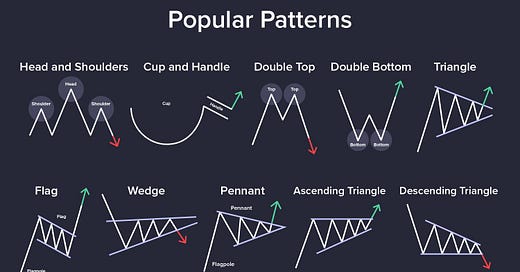Getting Started Guide
If you're new to trading, or looking to learn about technical analysis and options, I'm here to share what I've learned from some of the best & brightest over the last few years of full-time trading.
Disclaimer: These are my learnings and opinions only, not financial advice.
"The stock market will do whatever it has to do to embarrass the greatest number of people to the greatest extent possible." — Walter Deemer
“Be fearful when others are greedy, and greedy when others are fearful." — Warren Buffett
In other words, the stock market is tricky. Contrarian indicators are all the rage. Good news can mean a stock tanks. The perfect setup in a stock chart can go in the complete opposite direction. And with options, you can pick the right stock in the right direction but still lose if your timing is off.
I’ve worked in tech across both big companies and high growth startups in Product Management for 20+ yrs, but have been trading and, more importantly, studying and learning about stock/options trading (mostly) full-time since 2018. I combine technical analysis, studying options flow and news, and reading tweets from people much smarter than me to find high probability trades.
At the end of the day, I also find it useful to take a step back and write down my market thoughts to make sure I’m seeing the forest for the trees. Also I often get questions from friends often — some who trade regularly like me and others who are a lot more hands off but need a pulse on the market. I’ve decided to share my market thoughts in this recurring newsletter. Like most things, it’s a work in progress, so please send your feedback.
This “getting started” content will help you get familiar with my terminology, tools, and trading style. You can also follow some of my trades in real-time on X @liquid_trader.
What I Look At
This section is not exhaustive by any means but it’s a starting point for the terms and tools I use often. And don’t worry if you get a bit lost — it’ll become second nature in no time.
/ES, or E-mini S&P 500 Futures: While the S&P 500 ($SPX) is an index that tracks the performance of 500 top U.S. companies, you can think of /ES as a way to trade where you believe the index will be in the future. /ES runs almost 24 hours a day during the week, so it’s useful to see how after hours news affects the markets.
SPY 0.00%↑ The most popular index fund that tracks the S&P 500.
QQQ 0.00%↑ The most popular index fund that tracks the Nasdaq 100, the top non-financial (mostly tech) companies on the Nasdaq.
Call Options and Put Options: Calls and puts allow traders to capture moves in stocks without having to buy .
A call gives you the right to buy a stock at a specific price before a certain date, which is great if you think the stock will go up.
A put lets you sell a stock at a specific price, useful if you think the stock will go down.
VWAP (Volume-Weighted Average Price): The average price a stock has traded at during the day, weighted by trading volume. This is a must-add to your charts, as it often represents a good intraday dip-buy opportunity for names trending up that day.
SMA (Simple Moving Average) and EMA (Exponential Moving Average): Every chart I use has multiple moving averages that are essential for tracking price action. On the daily chart, for example, I would consider the 8EMA, 20SMA, 50SMA, 100SMA, and 200SMA as must-adds. As a general rule, I’m bullish if any name (including and especially the indices like SPY 0.00%↑, QQQ 0.00%↑, and /ES S&P 500 E-mini Futures) is above the 8-day exponential moving average (8EMA) AND 20-day simple moving average (20SMA). In the chart below, you have the 8EMA in blue and 20SMA is red. When the 8 > 20, it’s in an uptrend (I’ll look to buy calls on it); when the 8 < 20, it’s in a downtrend (I’ll look buy puts on it). When SPY 0.00%↑ QQQ 0.00%↑ are below the 8/20, I try to size down considerably on any long positions and focus more on shorting.
Keep reading with a 7-day free trial
Subscribe to The Liquid Update to keep reading this post and get 7 days of free access to the full post archives.




